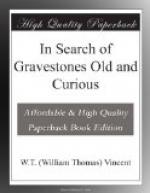south to blossom forth had he not been checked by
the rigours of the Church. At times indeed the
mortal passion for a name to live to posterity was
too strong to be altogether curbed, as we may see
manifested even in the prescribed initials when they
are moulded of heroic size, from 8 to 10 inches being
no uncommon height. Remarkable also is the fact
just mentioned (page 86) that, concurrently with the
erection of these dumb headstones, there were flat
or table stones[14] allowed, upon which not only were
the names and virtues of the departed fully set forth,
but all sorts of emblematical devices introduced.
The table tomb was probably in itself a vanity, and,
the boundary passed, there appears to have been no
limit to its excesses. There are a great many
instances of this at Inverness, Aberdeen, Keith, Dunblane,
and elsewhere, and the stone which appears in the
sketch from Braemar is only one of several in that
very limited space. Such exceptional cases seem
to indicate some local relaxation from the austerity
of the period, which was apparently most intense in
the centres of population. Humility at the grave
extended even to the material of the gravestone.
At Aberdeen, the Granite City, few of the last-century
gravestones are of any better material than the soft
sandstones which must have been imported from Elgin
or the south. The rule of initials was almost
universal. In like manner, when it became the
custom to purchase grave-spaces, the simplest possible
words were employed to denote the ownership.
I noticed one stone in Aberdeen bearing on its face
the medallion portrait of a lady, and only the words
of Isaiah, chapter xl. verse 6: “The voice
said, All flesh is grass, and all the goodliness thereof
is as the flower of the field.” At the back
of the stone is written: “This burying
ground, containing two graves, belongs to William
Rait, Merchant. Aberdeen, 1800.” The
practice of carving on both faces of the headstone
is very common in Scotland, and, so far as I have
observed, in Scotland alone; but, strange as it may
seem, Scotland and Ireland when they write gravestone
inscriptions have one habit in common, that of beginning
their epitaphs, not with the name of the deceased
person, but with the name of the person who provides
the stone. Thus:—
Erected by William Brown
to his Father John Brown,
etc., etc.
[Footnote 14: It has been suggested to me that these “tombs” were the luxuries of the wealthier inhabitants.]
[Illustration: Fig. 95. Blairgowrie.]
[Illustration: Fig. 96. Laufen.
1. Cut into stone.
2. Anchor of iron on dwarf stone pillar.
3. Heart and anchor of thin iron on dwarf stone pillar.
4. Iron plate and rod.
5. Wooden cross.
6. Wooden cross.]
CHAPTER XII.
Old gravestones abroad.




